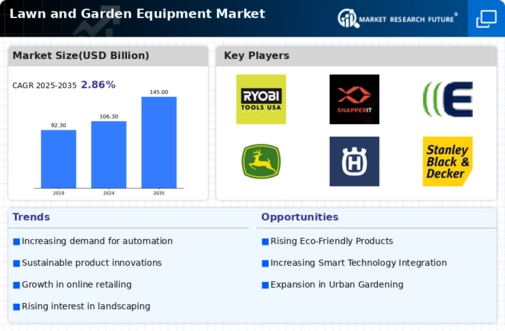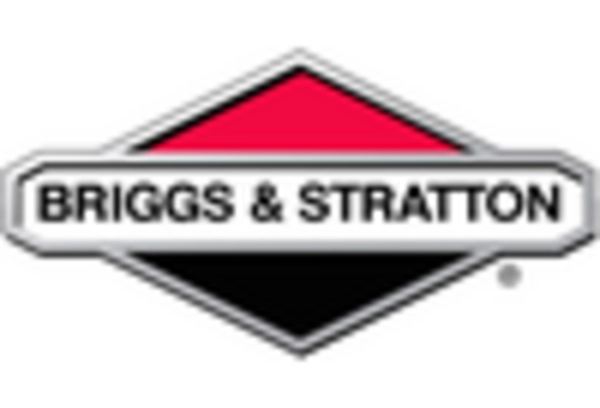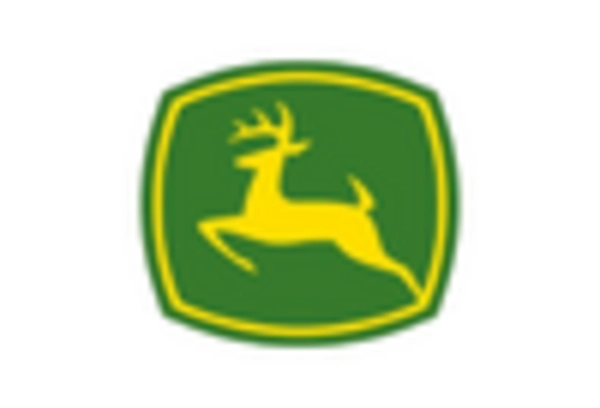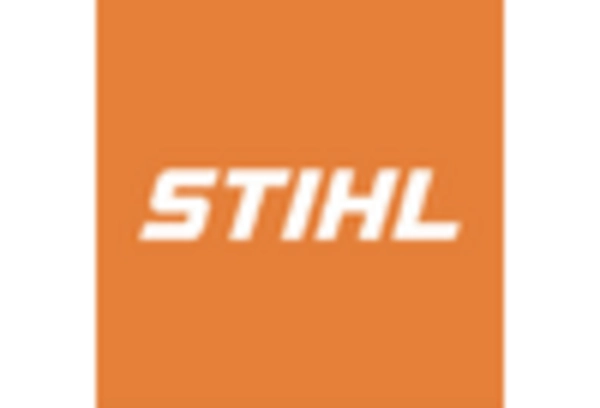-
EXECUTIVE SUMMARY
-
Market Overview
-
Key Findings
-
Market Segmentation
-
Competitive Landscape
-
Challenges and Opportunities
-
Future Outlook
-
MARKET INTRODUCTION
-
Definition
-
Scope of the study
- Research Objective
- Assumption
- Limitations
-
RESEARCH METHODOLOGY
-
Overview
-
Data Mining
-
Secondary Research
-
Primary Research
- Primary Interviews and Information Gathering Process
- Breakdown of Primary Respondents
-
Forecasting Model
-
Market Size Estimation
- Bottom-Up Approach
- Top-Down Approach
-
Data Triangulation
-
Validation
-
MARKET DYNAMICS
-
Overview
-
Drivers
-
Restraints
-
Opportunities
-
MARKET FACTOR ANALYSIS
-
Value chain Analysis
-
Porter's Five Forces Analysis
- Bargaining Power of Suppliers
- Bargaining Power of Buyers
- Threat of New Entrants
- Threat of Substitutes
- Intensity of Rivalry
-
COVID-19 Impact Analysis
- Market Impact Analysis
- Regional Impact
- Opportunity and Threat Analysis
-
LAWN AND GARDEN EQUIPMENT MARKET, BY TYPE (USD BILLION)
-
Handheld Equipment
-
Power Tools
-
Riding Equipment
-
Walk-Behind Equipment
-
LAWN AND GARDEN EQUIPMENT MARKET, BY EQUIPMENT CATEGORY (USD BILLION)
-
Lawn Mowers
-
Trimmers and Edgers
-
Chainsaws
-
Blowers and Vacuums
-
Tillers
-
LAWN AND GARDEN EQUIPMENT MARKET, BY POWER SOURCE (USD BILLION)
-
Electric
-
Gasoline
-
Battery Operated
-
LAWN AND GARDEN EQUIPMENT MARKET, BY END USE (USD BILLION)
-
Residential
-
Commercial
-
Public Sector
-
LAWN AND GARDEN EQUIPMENT MARKET, BY REGIONAL (USD BILLION)
-
North America
- US
- Canada
-
Europe
- Germany
- UK
- France
- Russia
- Italy
- Spain
- Rest of Europe
-
APAC
- China
- India
- Japan
- South Korea
- Malaysia
- Thailand
- Indonesia
- Rest of APAC
-
South America
- Brazil
- Mexico
- Argentina
- Rest of South America
-
MEA
- GCC Countries
- South Africa
- Rest of MEA
-
COMPETITIVE LANDSCAPE
-
Overview
-
Competitive Analysis
-
Market share Analysis
-
Major Growth Strategy in the Lawn and Garden Equipment Market
-
Competitive Benchmarking
-
Leading Players in Terms of Number of Developments in the Lawn and Garden Equipment Market
-
Key developments and growth strategies
- New Product Launch/Service Deployment
- Merger & Acquisitions
- Joint Ventures
-
Major Players Financial Matrix
- Sales and Operating Income
- Major Players R&D Expenditure. 2023
-
COMPANY PROFILES
-
Toro Company
- Financial Overview
- Products Offered
- Key Developments
- SWOT Analysis
- Key Strategies
-
Stihl AG
- Financial Overview
- Products Offered
- Key Developments
- SWOT Analysis
- Key Strategies
-
Black & Decker
- Financial Overview
- Products Offered
- Key Developments
- SWOT Analysis
- Key Strategies
-
Ryobi
- Financial Overview
- Products Offered
- Key Developments
- SWOT Analysis
- Key Strategies
-
Snapper
- Financial Overview
- Products Offered
- Key Developments
- SWOT Analysis
- Key Strategies
-
Masport
- Financial Overview
- Products Offered
- Key Developments
- SWOT Analysis
- Key Strategies
-
Echo
- Financial Overview
- Products Offered
- Key Developments
- SWOT Analysis
- Key Strategies
-
John Deere
- Financial Overview
- Products Offered
- Key Developments
- SWOT Analysis
- Key Strategies
-
Husqvarna
- Financial Overview
- Products Offered
- Key Developments
- SWOT Analysis
- Key Strategies
-
Stanley Black & Decker
- Financial Overview
- Products Offered
- Key Developments
- SWOT Analysis
- Key Strategies
-
Briggs & Stratton
- Financial Overview
- Products Offered
- Key Developments
- SWOT Analysis
- Key Strategies
-
Craftsman
- Financial Overview
- Products Offered
- Key Developments
- SWOT Analysis
- Key Strategies
-
Landscapers Supply
- Financial Overview
- Products Offered
- Key Developments
- SWOT Analysis
- Key Strategies
-
Ariens Company
- Financial Overview
- Products Offered
- Key Developments
- SWOT Analysis
- Key Strategies
-
Kubota Corporation
- Financial Overview
- Products Offered
- Key Developments
- SWOT Analysis
- Key Strategies
-
APPENDIX
-
References
-
Related Reports
-
LIST OF TABLES
-
LIST OF ASSUMPTIONS
-
NORTH AMERICA LAWN AND GARDEN EQUIPMENT MARKET SIZE ESTIMATES & FORECAST, BY TYPE, 2019-2035 (USD BILLIONS)
-
NORTH AMERICA LAWN AND GARDEN EQUIPMENT MARKET SIZE ESTIMATES & FORECAST, BY EQUIPMENT CATEGORY, 2019-2035 (USD BILLIONS)
-
NORTH AMERICA LAWN AND GARDEN EQUIPMENT MARKET SIZE ESTIMATES & FORECAST, BY POWER SOURCE, 2019-2035 (USD BILLIONS)
-
NORTH AMERICA LAWN AND GARDEN EQUIPMENT MARKET SIZE ESTIMATES & FORECAST, BY END USE, 2019-2035 (USD BILLIONS)
-
NORTH AMERICA LAWN AND GARDEN EQUIPMENT MARKET SIZE ESTIMATES & FORECAST, BY REGIONAL, 2019-2035 (USD BILLIONS)
-
US LAWN AND GARDEN EQUIPMENT MARKET SIZE ESTIMATES & FORECAST, BY TYPE, 2019-2035 (USD BILLIONS)
-
US LAWN AND GARDEN EQUIPMENT MARKET SIZE ESTIMATES & FORECAST, BY EQUIPMENT CATEGORY, 2019-2035 (USD BILLIONS)
-
US LAWN AND GARDEN EQUIPMENT MARKET SIZE ESTIMATES & FORECAST, BY POWER SOURCE, 2019-2035 (USD BILLIONS)
-
US LAWN AND GARDEN EQUIPMENT MARKET SIZE ESTIMATES & FORECAST, BY END USE, 2019-2035 (USD BILLIONS)
-
US LAWN AND GARDEN EQUIPMENT MARKET SIZE ESTIMATES & FORECAST, BY REGIONAL, 2019-2035 (USD BILLIONS)
-
CANADA LAWN AND GARDEN EQUIPMENT MARKET SIZE ESTIMATES & FORECAST, BY TYPE, 2019-2035 (USD BILLIONS)
-
CANADA LAWN AND GARDEN EQUIPMENT MARKET SIZE ESTIMATES & FORECAST, BY EQUIPMENT CATEGORY, 2019-2035 (USD BILLIONS)
-
CANADA LAWN AND GARDEN EQUIPMENT MARKET SIZE ESTIMATES & FORECAST, BY POWER SOURCE, 2019-2035 (USD BILLIONS)
-
CANADA LAWN AND GARDEN EQUIPMENT MARKET SIZE ESTIMATES & FORECAST, BY END USE, 2019-2035 (USD BILLIONS)
-
CANADA LAWN AND GARDEN EQUIPMENT MARKET SIZE ESTIMATES & FORECAST, BY REGIONAL, 2019-2035 (USD BILLIONS)
-
EUROPE LAWN AND GARDEN EQUIPMENT MARKET SIZE ESTIMATES & FORECAST, BY TYPE, 2019-2035 (USD BILLIONS)
-
EUROPE LAWN AND GARDEN EQUIPMENT MARKET SIZE ESTIMATES & FORECAST, BY EQUIPMENT CATEGORY, 2019-2035 (USD BILLIONS)
-
EUROPE LAWN AND GARDEN EQUIPMENT MARKET SIZE ESTIMATES & FORECAST, BY POWER SOURCE, 2019-2035 (USD BILLIONS)
-
EUROPE LAWN AND GARDEN EQUIPMENT MARKET SIZE ESTIMATES & FORECAST, BY END USE, 2019-2035 (USD BILLIONS)
-
EUROPE LAWN AND GARDEN EQUIPMENT MARKET SIZE ESTIMATES & FORECAST, BY REGIONAL, 2019-2035 (USD BILLIONS)
-
GERMANY LAWN AND GARDEN EQUIPMENT MARKET SIZE ESTIMATES & FORECAST, BY TYPE, 2019-2035 (USD BILLIONS)
-
GERMANY LAWN AND GARDEN EQUIPMENT MARKET SIZE ESTIMATES & FORECAST, BY EQUIPMENT CATEGORY, 2019-2035 (USD BILLIONS)
-
GERMANY LAWN AND GARDEN EQUIPMENT MARKET SIZE ESTIMATES & FORECAST, BY POWER SOURCE, 2019-2035 (USD BILLIONS)
-
GERMANY LAWN AND GARDEN EQUIPMENT MARKET SIZE ESTIMATES & FORECAST, BY END USE, 2019-2035 (USD BILLIONS)
-
GERMANY LAWN AND GARDEN EQUIPMENT MARKET SIZE ESTIMATES & FORECAST, BY REGIONAL, 2019-2035 (USD BILLIONS)
-
UK LAWN AND GARDEN EQUIPMENT MARKET SIZE ESTIMATES & FORECAST, BY TYPE, 2019-2035 (USD BILLIONS)
-
UK LAWN AND GARDEN EQUIPMENT MARKET SIZE ESTIMATES & FORECAST, BY EQUIPMENT CATEGORY, 2019-2035 (USD BILLIONS)
-
UK LAWN AND GARDEN EQUIPMENT MARKET SIZE ESTIMATES & FORECAST, BY POWER SOURCE, 2019-2035 (USD BILLIONS)
-
UK LAWN AND GARDEN EQUIPMENT MARKET SIZE ESTIMATES & FORECAST, BY END USE, 2019-2035 (USD BILLIONS)
-
UK LAWN AND GARDEN EQUIPMENT MARKET SIZE ESTIMATES & FORECAST, BY REGIONAL, 2019-2035 (USD BILLIONS)
-
FRANCE LAWN AND GARDEN EQUIPMENT MARKET SIZE ESTIMATES & FORECAST, BY TYPE, 2019-2035 (USD BILLIONS)
-
FRANCE LAWN AND GARDEN EQUIPMENT MARKET SIZE ESTIMATES & FORECAST, BY EQUIPMENT CATEGORY, 2019-2035 (USD BILLIONS)
-
FRANCE LAWN AND GARDEN EQUIPMENT MARKET SIZE ESTIMATES & FORECAST, BY POWER SOURCE, 2019-2035 (USD BILLIONS)
-
FRANCE LAWN AND GARDEN EQUIPMENT MARKET SIZE ESTIMATES & FORECAST, BY END USE, 2019-2035 (USD BILLIONS)
-
FRANCE LAWN AND GARDEN EQUIPMENT MARKET SIZE ESTIMATES & FORECAST, BY REGIONAL, 2019-2035 (USD BILLIONS)
-
RUSSIA LAWN AND GARDEN EQUIPMENT MARKET SIZE ESTIMATES & FORECAST, BY TYPE, 2019-2035 (USD BILLIONS)
-
RUSSIA LAWN AND GARDEN EQUIPMENT MARKET SIZE ESTIMATES & FORECAST, BY EQUIPMENT CATEGORY, 2019-2035 (USD BILLIONS)
-
RUSSIA LAWN AND GARDEN EQUIPMENT MARKET SIZE ESTIMATES & FORECAST, BY POWER SOURCE, 2019-2035 (USD BILLIONS)
-
RUSSIA LAWN AND GARDEN EQUIPMENT MARKET SIZE ESTIMATES & FORECAST, BY END USE, 2019-2035 (USD BILLIONS)
-
RUSSIA LAWN AND GARDEN EQUIPMENT MARKET SIZE ESTIMATES & FORECAST, BY REGIONAL, 2019-2035 (USD BILLIONS)
-
ITALY LAWN AND GARDEN EQUIPMENT MARKET SIZE ESTIMATES & FORECAST, BY TYPE, 2019-2035 (USD BILLIONS)
-
ITALY LAWN AND GARDEN EQUIPMENT MARKET SIZE ESTIMATES & FORECAST, BY EQUIPMENT CATEGORY, 2019-2035 (USD BILLIONS)
-
ITALY LAWN AND GARDEN EQUIPMENT MARKET SIZE ESTIMATES & FORECAST, BY POWER SOURCE, 2019-2035 (USD BILLIONS)
-
ITALY LAWN AND GARDEN EQUIPMENT MARKET SIZE ESTIMATES & FORECAST, BY END USE, 2019-2035 (USD BILLIONS)
-
ITALY LAWN AND GARDEN EQUIPMENT MARKET SIZE ESTIMATES & FORECAST, BY REGIONAL, 2019-2035 (USD BILLIONS)
-
SPAIN LAWN AND GARDEN EQUIPMENT MARKET SIZE ESTIMATES & FORECAST, BY TYPE, 2019-2035 (USD BILLIONS)
-
SPAIN LAWN AND GARDEN EQUIPMENT MARKET SIZE ESTIMATES & FORECAST, BY EQUIPMENT CATEGORY, 2019-2035 (USD BILLIONS)
-
SPAIN LAWN AND GARDEN EQUIPMENT MARKET SIZE ESTIMATES & FORECAST, BY POWER SOURCE, 2019-2035 (USD BILLIONS)
-
SPAIN LAWN AND GARDEN EQUIPMENT MARKET SIZE ESTIMATES & FORECAST, BY END USE, 2019-2035 (USD BILLIONS)
-
SPAIN LAWN AND GARDEN EQUIPMENT MARKET SIZE ESTIMATES & FORECAST, BY REGIONAL, 2019-2035 (USD BILLIONS)
-
REST OF EUROPE LAWN AND GARDEN EQUIPMENT MARKET SIZE ESTIMATES & FORECAST, BY TYPE, 2019-2035 (USD BILLIONS)
-
REST OF EUROPE LAWN AND GARDEN EQUIPMENT MARKET SIZE ESTIMATES & FORECAST, BY EQUIPMENT CATEGORY, 2019-2035 (USD BILLIONS)
-
REST OF EUROPE LAWN AND GARDEN EQUIPMENT MARKET SIZE ESTIMATES & FORECAST, BY POWER SOURCE, 2019-2035 (USD BILLIONS)
-
REST OF EUROPE LAWN AND GARDEN EQUIPMENT MARKET SIZE ESTIMATES & FORECAST, BY END USE, 2019-2035 (USD BILLIONS)
-
REST OF EUROPE LAWN AND GARDEN EQUIPMENT MARKET SIZE ESTIMATES & FORECAST, BY REGIONAL, 2019-2035 (USD BILLIONS)
-
APAC LAWN AND GARDEN EQUIPMENT MARKET SIZE ESTIMATES & FORECAST, BY TYPE, 2019-2035 (USD BILLIONS)
-
APAC LAWN AND GARDEN EQUIPMENT MARKET SIZE ESTIMATES & FORECAST, BY EQUIPMENT CATEGORY, 2019-2035 (USD BILLIONS)
-
APAC LAWN AND GARDEN EQUIPMENT MARKET SIZE ESTIMATES & FORECAST, BY POWER SOURCE, 2019-2035 (USD BILLIONS)
-
APAC LAWN AND GARDEN EQUIPMENT MARKET SIZE ESTIMATES & FORECAST, BY END USE, 2019-2035 (USD BILLIONS)
-
APAC LAWN AND GARDEN EQUIPMENT MARKET SIZE ESTIMATES & FORECAST, BY REGIONAL, 2019-2035 (USD BILLIONS)
-
CHINA LAWN AND GARDEN EQUIPMENT MARKET SIZE ESTIMATES & FORECAST, BY TYPE, 2019-2035 (USD BILLIONS)
-
CHINA LAWN AND GARDEN EQUIPMENT MARKET SIZE ESTIMATES & FORECAST, BY EQUIPMENT CATEGORY, 2019-2035 (USD BILLIONS)
-
CHINA LAWN AND GARDEN EQUIPMENT MARKET SIZE ESTIMATES & FORECAST, BY POWER SOURCE, 2019-2035 (USD BILLIONS)
-
CHINA LAWN AND GARDEN EQUIPMENT MARKET SIZE ESTIMATES & FORECAST, BY END USE, 2019-2035 (USD BILLIONS)
-
CHINA LAWN AND GARDEN EQUIPMENT MARKET SIZE ESTIMATES & FORECAST, BY REGIONAL, 2019-2035 (USD BILLIONS)
-
INDIA LAWN AND GARDEN EQUIPMENT MARKET SIZE ESTIMATES & FORECAST, BY TYPE, 2019-2035 (USD BILLIONS)
-
INDIA LAWN AND GARDEN EQUIPMENT MARKET SIZE ESTIMATES & FORECAST, BY EQUIPMENT CATEGORY, 2019-2035 (USD BILLIONS)
-
INDIA LAWN AND GARDEN EQUIPMENT MARKET SIZE ESTIMATES & FORECAST, BY POWER SOURCE, 2019-2035 (USD BILLIONS)
-
INDIA LAWN AND GARDEN EQUIPMENT MARKET SIZE ESTIMATES & FORECAST, BY END USE, 2019-2035 (USD BILLIONS)
-
INDIA LAWN AND GARDEN EQUIPMENT MARKET SIZE ESTIMATES & FORECAST, BY REGIONAL, 2019-2035 (USD BILLIONS)
-
JAPAN LAWN AND GARDEN EQUIPMENT MARKET SIZE ESTIMATES & FORECAST, BY TYPE, 2019-2035 (USD BILLIONS)
-
JAPAN LAWN AND GARDEN EQUIPMENT MARKET SIZE ESTIMATES & FORECAST, BY EQUIPMENT CATEGORY, 2019-2035 (USD BILLIONS)
-
JAPAN LAWN AND GARDEN EQUIPMENT MARKET SIZE ESTIMATES & FORECAST, BY POWER SOURCE, 2019-2035 (USD BILLIONS)
-
JAPAN LAWN AND GARDEN EQUIPMENT MARKET SIZE ESTIMATES & FORECAST, BY END USE, 2019-2035 (USD BILLIONS)
-
JAPAN LAWN AND GARDEN EQUIPMENT MARKET SIZE ESTIMATES & FORECAST, BY REGIONAL, 2019-2035 (USD BILLIONS)
-
SOUTH KOREA LAWN AND GARDEN EQUIPMENT MARKET SIZE ESTIMATES & FORECAST, BY TYPE, 2019-2035 (USD BILLIONS)
-
SOUTH KOREA LAWN AND GARDEN EQUIPMENT MARKET SIZE ESTIMATES & FORECAST, BY EQUIPMENT CATEGORY, 2019-2035 (USD BILLIONS)
-
SOUTH KOREA LAWN AND GARDEN EQUIPMENT MARKET SIZE ESTIMATES & FORECAST, BY POWER SOURCE, 2019-2035 (USD BILLIONS)
-
SOUTH KOREA LAWN AND GARDEN EQUIPMENT MARKET SIZE ESTIMATES & FORECAST, BY END USE, 2019-2035 (USD BILLIONS)
-
SOUTH KOREA LAWN AND GARDEN EQUIPMENT MARKET SIZE ESTIMATES & FORECAST, BY REGIONAL, 2019-2035 (USD BILLIONS)
-
MALAYSIA LAWN AND GARDEN EQUIPMENT MARKET SIZE ESTIMATES & FORECAST, BY TYPE, 2019-2035 (USD BILLIONS)
-
MALAYSIA LAWN AND GARDEN EQUIPMENT MARKET SIZE ESTIMATES & FORECAST, BY EQUIPMENT CATEGORY, 2019-2035 (USD BILLIONS)
-
MALAYSIA LAWN AND GARDEN EQUIPMENT MARKET SIZE ESTIMATES & FORECAST, BY POWER SOURCE, 2019-2035 (USD BILLIONS)
-
MALAYSIA LAWN AND GARDEN EQUIPMENT MARKET SIZE ESTIMATES & FORECAST, BY END USE, 2019-2035 (USD BILLIONS)
-
MALAYSIA LAWN AND GARDEN EQUIPMENT MARKET SIZE ESTIMATES & FORECAST, BY REGIONAL, 2019-2035 (USD BILLIONS)
-
THAILAND LAWN AND GARDEN EQUIPMENT MARKET SIZE ESTIMATES & FORECAST, BY TYPE, 2019-2035 (USD BILLIONS)
-
THAILAND LAWN AND GARDEN EQUIPMENT MARKET SIZE ESTIMATES & FORECAST, BY EQUIPMENT CATEGORY, 2019-2035 (USD BILLIONS)
-
THAILAND LAWN AND GARDEN EQUIPMENT MARKET SIZE ESTIMATES & FORECAST, BY POWER SOURCE, 2019-2035 (USD BILLIONS)
-
THAILAND LAWN AND GARDEN EQUIPMENT MARKET SIZE ESTIMATES & FORECAST, BY END USE, 2019-2035 (USD BILLIONS)
-
THAILAND LAWN AND GARDEN EQUIPMENT MARKET SIZE ESTIMATES & FORECAST, BY REGIONAL, 2019-2035 (USD BILLIONS)
-
INDONESIA LAWN AND GARDEN EQUIPMENT MARKET SIZE ESTIMATES & FORECAST, BY TYPE, 2019-2035 (USD BILLIONS)
-
INDONESIA LAWN AND GARDEN EQUIPMENT MARKET SIZE ESTIMATES & FORECAST, BY EQUIPMENT CATEGORY, 2019-2035 (USD BILLIONS)
-
INDONESIA LAWN AND GARDEN EQUIPMENT MARKET SIZE ESTIMATES & FORECAST, BY POWER SOURCE, 2019-2035 (USD BILLIONS)
-
INDONESIA LAWN AND GARDEN EQUIPMENT MARKET SIZE ESTIMATES & FORECAST, BY END USE, 2019-2035 (USD BILLIONS)
-
INDONESIA LAWN AND GARDEN EQUIPMENT MARKET SIZE ESTIMATES & FORECAST, BY REGIONAL, 2019-2035 (USD BILLIONS)
-
REST OF APAC LAWN AND GARDEN EQUIPMENT MARKET SIZE ESTIMATES & FORECAST, BY TYPE, 2019-2035 (USD BILLIONS)
-
REST OF APAC LAWN AND GARDEN EQUIPMENT MARKET SIZE ESTIMATES & FORECAST, BY EQUIPMENT CATEGORY, 2019-2035 (USD BILLIONS)
-
REST OF APAC LAWN AND GARDEN EQUIPMENT MARKET SIZE ESTIMATES & FORECAST, BY POWER SOURCE, 2019-2035 (USD BILLIONS)
-
REST OF APAC LAWN AND GARDEN EQUIPMENT MARKET SIZE ESTIMATES & FORECAST, BY END USE, 2019-2035 (USD BILLIONS)
-
REST OF APAC LAWN AND GARDEN EQUIPMENT MARKET SIZE ESTIMATES & FORECAST, BY REGIONAL, 2019-2035 (USD BILLIONS)
-
SOUTH AMERICA LAWN AND GARDEN EQUIPMENT MARKET SIZE ESTIMATES & FORECAST, BY TYPE, 2019-2035 (USD BILLIONS)
-
SOUTH AMERICA LAWN AND GARDEN EQUIPMENT MARKET SIZE ESTIMATES & FORECAST, BY EQUIPMENT CATEGORY, 2019-2035 (USD BILLIONS)
-
SOUTH AMERICA LAWN AND GARDEN EQUIPMENT MARKET SIZE ESTIMATES & FORECAST, BY POWER SOURCE, 2019-2035 (USD BILLIONS)
-
SOUTH AMERICA LAWN AND GARDEN EQUIPMENT MARKET SIZE ESTIMATES & FORECAST, BY END USE, 2019-2035 (USD BILLIONS)
-
SOUTH AMERICA LAWN AND GARDEN EQUIPMENT MARKET SIZE ESTIMATES & FORECAST, BY REGIONAL, 2019-2035 (USD BILLIONS)
-
BRAZIL LAWN AND GARDEN EQUIPMENT MARKET SIZE ESTIMATES & FORECAST, BY TYPE, 2019-2035 (USD BILLIONS)
-
BRAZIL LAWN AND GARDEN EQUIPMENT MARKET SIZE ESTIMATES & FORECAST, BY EQUIPMENT CATEGORY, 2019-2035 (USD BILLIONS)
-
BRAZIL LAWN AND GARDEN EQUIPMENT MARKET SIZE ESTIMATES & FORECAST, BY POWER SOURCE, 2019-2035 (USD BILLIONS)
-
BRAZIL LAWN AND GARDEN EQUIPMENT MARKET SIZE ESTIMATES & FORECAST, BY END USE, 2019-2035 (USD BILLIONS)
-
BRAZIL LAWN AND GARDEN EQUIPMENT MARKET SIZE ESTIMATES & FORECAST, BY REGIONAL, 2019-2035 (USD BILLIONS)
-
MEXICO LAWN AND GARDEN EQUIPMENT MARKET SIZE ESTIMATES & FORECAST, BY TYPE, 2019-2035 (USD BILLIONS)
-
MEXICO LAWN AND GARDEN EQUIPMENT MARKET SIZE ESTIMATES & FORECAST, BY EQUIPMENT CATEGORY, 2019-2035 (USD BILLIONS)
-
MEXICO LAWN AND GARDEN EQUIPMENT MARKET SIZE ESTIMATES & FORECAST, BY POWER SOURCE, 2019-2035 (USD BILLIONS)
-
MEXICO LAWN AND GARDEN EQUIPMENT MARKET SIZE ESTIMATES & FORECAST, BY END USE, 2019-2035 (USD BILLIONS)
-
MEXICO LAWN AND GARDEN EQUIPMENT MARKET SIZE ESTIMATES & FORECAST, BY REGIONAL, 2019-2035 (USD BILLIONS)
-
ARGENTINA LAWN AND GARDEN EQUIPMENT MARKET SIZE ESTIMATES & FORECAST, BY TYPE, 2019-2035 (USD BILLIONS)
-
ARGENTINA LAWN AND GARDEN EQUIPMENT MARKET SIZE ESTIMATES & FORECAST, BY EQUIPMENT CATEGORY, 2019-2035 (USD BILLIONS)
-
ARGENTINA LAWN AND GARDEN EQUIPMENT MARKET SIZE ESTIMATES & FORECAST, BY POWER SOURCE, 2019-2035 (USD BILLIONS)
-
ARGENTINA LAWN AND GARDEN EQUIPMENT MARKET SIZE ESTIMATES & FORECAST, BY END USE, 2019-2035 (USD BILLIONS)
-
ARGENTINA LAWN AND GARDEN EQUIPMENT MARKET SIZE ESTIMATES & FORECAST, BY REGIONAL, 2019-2035 (USD BILLIONS)
-
REST OF SOUTH AMERICA LAWN AND GARDEN EQUIPMENT MARKET SIZE ESTIMATES & FORECAST, BY TYPE, 2019-2035 (USD BILLIONS)
-
REST OF SOUTH AMERICA LAWN AND GARDEN EQUIPMENT MARKET SIZE ESTIMATES & FORECAST, BY EQUIPMENT CATEGORY, 2019-2035 (USD BILLIONS)
-
REST OF SOUTH AMERICA LAWN AND GARDEN EQUIPMENT MARKET SIZE ESTIMATES & FORECAST, BY POWER SOURCE, 2019-2035 (USD BILLIONS)
-
REST OF SOUTH AMERICA LAWN AND GARDEN EQUIPMENT MARKET SIZE ESTIMATES & FORECAST, BY END USE, 2019-2035 (USD BILLIONS)
-
REST OF SOUTH AMERICA LAWN AND GARDEN EQUIPMENT MARKET SIZE ESTIMATES & FORECAST, BY REGIONAL, 2019-2035 (USD BILLIONS)
-
MEA LAWN AND GARDEN EQUIPMENT MARKET SIZE ESTIMATES & FORECAST, BY TYPE, 2019-2035 (USD BILLIONS)
-
MEA LAWN AND GARDEN EQUIPMENT MARKET SIZE ESTIMATES & FORECAST, BY EQUIPMENT CATEGORY, 2019-2035 (USD BILLIONS)
-
MEA LAWN AND GARDEN EQUIPMENT MARKET SIZE ESTIMATES & FORECAST, BY POWER SOURCE, 2019-2035 (USD BILLIONS)
-
MEA LAWN AND GARDEN EQUIPMENT MARKET SIZE ESTIMATES & FORECAST, BY END USE, 2019-2035 (USD BILLIONS)
-
MEA LAWN AND GARDEN EQUIPMENT MARKET SIZE ESTIMATES & FORECAST, BY REGIONAL, 2019-2035 (USD BILLIONS)
-
GCC COUNTRIES LAWN AND GARDEN EQUIPMENT MARKET SIZE ESTIMATES & FORECAST, BY TYPE, 2019-2035 (USD BILLIONS)
-
GCC COUNTRIES LAWN AND GARDEN EQUIPMENT MARKET SIZE ESTIMATES & FORECAST, BY EQUIPMENT CATEGORY, 2019-2035 (USD BILLIONS)
-
GCC COUNTRIES LAWN AND GARDEN EQUIPMENT MARKET SIZE ESTIMATES & FORECAST, BY POWER SOURCE, 2019-2035 (USD BILLIONS)
-
GCC COUNTRIES LAWN AND GARDEN EQUIPMENT MARKET SIZE ESTIMATES & FORECAST, BY END USE, 2019-2035 (USD BILLIONS)
-
GCC COUNTRIES LAWN AND GARDEN EQUIPMENT MARKET SIZE ESTIMATES & FORECAST, BY REGIONAL, 2019-2035 (USD BILLIONS)
-
SOUTH AFRICA LAWN AND GARDEN EQUIPMENT MARKET SIZE ESTIMATES & FORECAST, BY TYPE, 2019-2035 (USD BILLIONS)
-
SOUTH AFRICA LAWN AND GARDEN EQUIPMENT MARKET SIZE ESTIMATES & FORECAST, BY EQUIPMENT CATEGORY, 2019-2035 (USD BILLIONS)
-
SOUTH AFRICA LAWN AND GARDEN EQUIPMENT MARKET SIZE ESTIMATES & FORECAST, BY POWER SOURCE, 2019-2035 (USD BILLIONS)
-
SOUTH AFRICA LAWN AND GARDEN EQUIPMENT MARKET SIZE ESTIMATES & FORECAST, BY END USE, 2019-2035 (USD BILLIONS)
-
SOUTH AFRICA LAWN AND GARDEN EQUIPMENT MARKET SIZE ESTIMATES & FORECAST, BY REGIONAL, 2019-2035 (USD BILLIONS)
-
REST OF MEA LAWN AND GARDEN EQUIPMENT MARKET SIZE ESTIMATES & FORECAST, BY TYPE, 2019-2035 (USD BILLIONS)
-
REST OF MEA LAWN AND GARDEN EQUIPMENT MARKET SIZE ESTIMATES & FORECAST, BY EQUIPMENT CATEGORY, 2019-2035 (USD BILLIONS)
-
REST OF MEA LAWN AND GARDEN EQUIPMENT MARKET SIZE ESTIMATES & FORECAST, BY POWER SOURCE, 2019-2035 (USD BILLIONS)
-
REST OF MEA LAWN AND GARDEN EQUIPMENT MARKET SIZE ESTIMATES & FORECAST, BY END USE, 2019-2035 (USD BILLIONS)
-
REST OF MEA LAWN AND GARDEN EQUIPMENT MARKET SIZE ESTIMATES & FORECAST, BY REGIONAL, 2019-2035 (USD BILLIONS)
-
PRODUCT LAUNCH/PRODUCT DEVELOPMENT/APPROVAL
-
ACQUISITION/PARTNERSHIP
-
LIST OF FIGURES
-
MARKET SYNOPSIS
-
NORTH AMERICA LAWN AND GARDEN EQUIPMENT MARKET ANALYSIS
-
US LAWN AND GARDEN EQUIPMENT MARKET ANALYSIS BY TYPE
-
US LAWN AND GARDEN EQUIPMENT MARKET ANALYSIS BY EQUIPMENT CATEGORY
-
US LAWN AND GARDEN EQUIPMENT MARKET ANALYSIS BY POWER SOURCE
-
US LAWN AND GARDEN EQUIPMENT MARKET ANALYSIS BY END USE
-
US LAWN AND GARDEN EQUIPMENT MARKET ANALYSIS BY REGIONAL
-
CANADA LAWN AND GARDEN EQUIPMENT MARKET ANALYSIS BY TYPE
-
CANADA LAWN AND GARDEN EQUIPMENT MARKET ANALYSIS BY EQUIPMENT CATEGORY
-
CANADA LAWN AND GARDEN EQUIPMENT MARKET ANALYSIS BY POWER SOURCE
-
CANADA LAWN AND GARDEN EQUIPMENT MARKET ANALYSIS BY END USE
-
CANADA LAWN AND GARDEN EQUIPMENT MARKET ANALYSIS BY REGIONAL
-
EUROPE LAWN AND GARDEN EQUIPMENT MARKET ANALYSIS
-
GERMANY LAWN AND GARDEN EQUIPMENT MARKET ANALYSIS BY TYPE
-
GERMANY LAWN AND GARDEN EQUIPMENT MARKET ANALYSIS BY EQUIPMENT CATEGORY
-
GERMANY LAWN AND GARDEN EQUIPMENT MARKET ANALYSIS BY POWER SOURCE
-
GERMANY LAWN AND GARDEN EQUIPMENT MARKET ANALYSIS BY END USE
-
GERMANY LAWN AND GARDEN EQUIPMENT MARKET ANALYSIS BY REGIONAL
-
UK LAWN AND GARDEN EQUIPMENT MARKET ANALYSIS BY TYPE
-
UK LAWN AND GARDEN EQUIPMENT MARKET ANALYSIS BY EQUIPMENT CATEGORY
-
UK LAWN AND GARDEN EQUIPMENT MARKET ANALYSIS BY POWER SOURCE
-
UK LAWN AND GARDEN EQUIPMENT MARKET ANALYSIS BY END USE
-
UK LAWN AND GARDEN EQUIPMENT MARKET ANALYSIS BY REGIONAL
-
FRANCE LAWN AND GARDEN EQUIPMENT MARKET ANALYSIS BY TYPE
-
FRANCE LAWN AND GARDEN EQUIPMENT MARKET ANALYSIS BY EQUIPMENT CATEGORY
-
FRANCE LAWN AND GARDEN EQUIPMENT MARKET ANALYSIS BY POWER SOURCE
-
FRANCE LAWN AND GARDEN EQUIPMENT MARKET ANALYSIS BY END USE
-
FRANCE LAWN AND GARDEN EQUIPMENT MARKET ANALYSIS BY REGIONAL
-
RUSSIA LAWN AND GARDEN EQUIPMENT MARKET ANALYSIS BY TYPE
-
RUSSIA LAWN AND GARDEN EQUIPMENT MARKET ANALYSIS BY EQUIPMENT CATEGORY
-
RUSSIA LAWN AND GARDEN EQUIPMENT MARKET ANALYSIS BY POWER SOURCE
-
RUSSIA LAWN AND GARDEN EQUIPMENT MARKET ANALYSIS BY END USE
-
RUSSIA LAWN AND GARDEN EQUIPMENT MARKET ANALYSIS BY REGIONAL
-
ITALY LAWN AND GARDEN EQUIPMENT MARKET ANALYSIS BY TYPE
-
ITALY LAWN AND GARDEN EQUIPMENT MARKET ANALYSIS BY EQUIPMENT CATEGORY
-
ITALY LAWN AND GARDEN EQUIPMENT MARKET ANALYSIS BY POWER SOURCE
-
ITALY LAWN AND GARDEN EQUIPMENT MARKET ANALYSIS BY END USE
-
ITALY LAWN AND GARDEN EQUIPMENT MARKET ANALYSIS BY REGIONAL
-
SPAIN LAWN AND GARDEN EQUIPMENT MARKET ANALYSIS BY TYPE
-
SPAIN LAWN AND GARDEN EQUIPMENT MARKET ANALYSIS BY EQUIPMENT CATEGORY
-
SPAIN LAWN AND GARDEN EQUIPMENT MARKET ANALYSIS BY POWER SOURCE
-
SPAIN LAWN AND GARDEN EQUIPMENT MARKET ANALYSIS BY END USE
-
SPAIN LAWN AND GARDEN EQUIPMENT MARKET ANALYSIS BY REGIONAL
-
REST OF EUROPE LAWN AND GARDEN EQUIPMENT MARKET ANALYSIS BY TYPE
-
REST OF EUROPE LAWN AND GARDEN EQUIPMENT MARKET ANALYSIS BY EQUIPMENT CATEGORY
-
REST OF EUROPE LAWN AND GARDEN EQUIPMENT MARKET ANALYSIS BY POWER SOURCE
-
REST OF EUROPE LAWN AND GARDEN EQUIPMENT MARKET ANALYSIS BY END USE
-
REST OF EUROPE LAWN AND GARDEN EQUIPMENT MARKET ANALYSIS BY REGIONAL
-
APAC LAWN AND GARDEN EQUIPMENT MARKET ANALYSIS
-
CHINA LAWN AND GARDEN EQUIPMENT MARKET ANALYSIS BY TYPE
-
CHINA LAWN AND GARDEN EQUIPMENT MARKET ANALYSIS BY EQUIPMENT CATEGORY
-
CHINA LAWN AND GARDEN EQUIPMENT MARKET ANALYSIS BY POWER SOURCE
-
CHINA LAWN AND GARDEN EQUIPMENT MARKET ANALYSIS BY END USE
-
CHINA LAWN AND GARDEN EQUIPMENT MARKET ANALYSIS BY REGIONAL
-
INDIA LAWN AND GARDEN EQUIPMENT MARKET ANALYSIS BY TYPE
-
INDIA LAWN AND GARDEN EQUIPMENT MARKET ANALYSIS BY EQUIPMENT CATEGORY
-
INDIA LAWN AND GARDEN EQUIPMENT MARKET ANALYSIS BY POWER SOURCE
-
INDIA LAWN AND GARDEN EQUIPMENT MARKET ANALYSIS BY END USE
-
INDIA LAWN AND GARDEN EQUIPMENT MARKET ANALYSIS BY REGIONAL
-
JAPAN LAWN AND GARDEN EQUIPMENT MARKET ANALYSIS BY TYPE
-
JAPAN LAWN AND GARDEN EQUIPMENT MARKET ANALYSIS BY EQUIPMENT CATEGORY
-
JAPAN LAWN AND GARDEN EQUIPMENT MARKET ANALYSIS BY POWER SOURCE
-
JAPAN LAWN AND GARDEN EQUIPMENT MARKET ANALYSIS BY END USE
-
JAPAN LAWN AND GARDEN EQUIPMENT MARKET ANALYSIS BY REGIONAL
-
SOUTH KOREA LAWN AND GARDEN EQUIPMENT MARKET ANALYSIS BY TYPE
-
SOUTH KOREA LAWN AND GARDEN EQUIPMENT MARKET ANALYSIS BY EQUIPMENT CATEGORY
-
SOUTH KOREA LAWN AND GARDEN EQUIPMENT MARKET ANALYSIS BY POWER SOURCE
-
SOUTH KOREA LAWN AND GARDEN EQUIPMENT MARKET ANALYSIS BY END USE
-
SOUTH KOREA LAWN AND GARDEN EQUIPMENT MARKET ANALYSIS BY REGIONAL
-
MALAYSIA LAWN AND GARDEN EQUIPMENT MARKET ANALYSIS BY TYPE
-
MALAYSIA LAWN AND GARDEN EQUIPMENT MARKET ANALYSIS BY EQUIPMENT CATEGORY
-
MALAYSIA LAWN AND GARDEN EQUIPMENT MARKET ANALYSIS BY POWER SOURCE
-
MALAYSIA LAWN AND GARDEN EQUIPMENT MARKET ANALYSIS BY END USE
-
MALAYSIA LAWN AND GARDEN EQUIPMENT MARKET ANALYSIS BY REGIONAL
-
THAILAND LAWN AND GARDEN EQUIPMENT MARKET ANALYSIS BY TYPE
-
THAILAND LAWN AND GARDEN EQUIPMENT MARKET ANALYSIS BY EQUIPMENT CATEGORY
-
THAILAND LAWN AND GARDEN EQUIPMENT MARKET ANALYSIS BY POWER SOURCE
-
THAILAND LAWN AND GARDEN EQUIPMENT MARKET ANALYSIS BY END USE
-
THAILAND LAWN AND GARDEN EQUIPMENT MARKET ANALYSIS BY REGIONAL
-
INDONESIA LAWN AND GARDEN EQUIPMENT MARKET ANALYSIS BY TYPE
-
INDONESIA LAWN AND GARDEN EQUIPMENT MARKET ANALYSIS BY EQUIPMENT CATEGORY
-
INDONESIA LAWN AND GARDEN EQUIPMENT MARKET ANALYSIS BY POWER SOURCE
-
INDONESIA LAWN AND GARDEN EQUIPMENT MARKET ANALYSIS BY END USE
-
INDONESIA LAWN AND GARDEN EQUIPMENT MARKET ANALYSIS BY REGIONAL
-
REST OF APAC LAWN AND GARDEN EQUIPMENT MARKET ANALYSIS BY TYPE
-
REST OF APAC LAWN AND GARDEN EQUIPMENT MARKET ANALYSIS BY EQUIPMENT CATEGORY
-
REST OF APAC LAWN AND GARDEN EQUIPMENT MARKET ANALYSIS BY POWER SOURCE
-
REST OF APAC LAWN AND GARDEN EQUIPMENT MARKET ANALYSIS BY END USE
-
REST OF APAC LAWN AND GARDEN EQUIPMENT MARKET ANALYSIS BY REGIONAL
-
SOUTH AMERICA LAWN AND GARDEN EQUIPMENT MARKET ANALYSIS
-
BRAZIL LAWN AND GARDEN EQUIPMENT MARKET ANALYSIS BY TYPE
-
BRAZIL LAWN AND GARDEN EQUIPMENT MARKET ANALYSIS BY EQUIPMENT CATEGORY
-
BRAZIL LAWN AND GARDEN EQUIPMENT MARKET ANALYSIS BY POWER SOURCE
-
BRAZIL LAWN AND GARDEN EQUIPMENT MARKET ANALYSIS BY END USE
-
BRAZIL LAWN AND GARDEN EQUIPMENT MARKET ANALYSIS BY REGIONAL
-
MEXICO LAWN AND GARDEN EQUIPMENT MARKET ANALYSIS BY TYPE
-
MEXICO LAWN AND GARDEN EQUIPMENT MARKET ANALYSIS BY EQUIPMENT CATEGORY
-
MEXICO LAWN AND GARDEN EQUIPMENT MARKET ANALYSIS BY POWER SOURCE
-
MEXICO LAWN AND GARDEN EQUIPMENT MARKET ANALYSIS BY END USE
-
MEXICO LAWN AND GARDEN EQUIPMENT MARKET ANALYSIS BY REGIONAL
-
ARGENTINA LAWN AND GARDEN EQUIPMENT MARKET ANALYSIS BY TYPE
-
ARGENTINA LAWN AND GARDEN EQUIPMENT MARKET ANALYSIS BY EQUIPMENT CATEGORY
-
ARGENTINA LAWN AND GARDEN EQUIPMENT MARKET ANALYSIS BY POWER SOURCE
-
ARGENTINA LAWN AND GARDEN EQUIPMENT MARKET ANALYSIS BY END USE
-
ARGENTINA LAWN AND GARDEN EQUIPMENT MARKET ANALYSIS BY REGIONAL
-
REST OF SOUTH AMERICA LAWN AND GARDEN EQUIPMENT MARKET ANALYSIS BY TYPE
-
REST OF SOUTH AMERICA LAWN AND GARDEN EQUIPMENT MARKET ANALYSIS BY EQUIPMENT CATEGORY
-
REST OF SOUTH AMERICA LAWN AND GARDEN EQUIPMENT MARKET ANALYSIS BY POWER SOURCE
-
REST OF SOUTH AMERICA LAWN AND GARDEN EQUIPMENT MARKET ANALYSIS BY END USE
-
REST OF SOUTH AMERICA LAWN AND GARDEN EQUIPMENT MARKET ANALYSIS BY REGIONAL
-
MEA LAWN AND GARDEN EQUIPMENT MARKET ANALYSIS
-
GCC COUNTRIES LAWN AND GARDEN EQUIPMENT MARKET ANALYSIS BY TYPE
-
GCC COUNTRIES LAWN AND GARDEN EQUIPMENT MARKET ANALYSIS BY EQUIPMENT CATEGORY
-
GCC COUNTRIES LAWN AND GARDEN EQUIPMENT MARKET ANALYSIS BY POWER SOURCE
-
GCC COUNTRIES LAWN AND GARDEN EQUIPMENT MARKET ANALYSIS BY END USE
-
GCC COUNTRIES LAWN AND GARDEN EQUIPMENT MARKET ANALYSIS BY REGIONAL
-
SOUTH AFRICA LAWN AND GARDEN EQUIPMENT MARKET ANALYSIS BY TYPE
-
SOUTH AFRICA LAWN AND GARDEN EQUIPMENT MARKET ANALYSIS BY EQUIPMENT CATEGORY
-
SOUTH AFRICA LAWN AND GARDEN EQUIPMENT MARKET ANALYSIS BY POWER SOURCE
-
SOUTH AFRICA LAWN AND GARDEN EQUIPMENT MARKET ANALYSIS BY END USE
-
SOUTH AFRICA LAWN AND GARDEN EQUIPMENT MARKET ANALYSIS BY REGIONAL
-
REST OF MEA LAWN AND GARDEN EQUIPMENT MARKET ANALYSIS BY TYPE
-
REST OF MEA LAWN AND GARDEN EQUIPMENT MARKET ANALYSIS BY EQUIPMENT CATEGORY
-
REST OF MEA LAWN AND GARDEN EQUIPMENT MARKET ANALYSIS BY POWER SOURCE
-
REST OF MEA LAWN AND GARDEN EQUIPMENT MARKET ANALYSIS BY END USE
-
REST OF MEA LAWN AND GARDEN EQUIPMENT MARKET ANALYSIS BY REGIONAL
-
KEY BUYING CRITERIA OF LAWN AND GARDEN EQUIPMENT MARKET
-
RESEARCH PROCESS OF MRFR
-
DRO ANALYSIS OF LAWN AND GARDEN EQUIPMENT MARKET
-
DRIVERS IMPACT ANALYSIS: LAWN AND GARDEN EQUIPMENT MARKET
-
RESTRAINTS IMPACT ANALYSIS: LAWN AND GARDEN EQUIPMENT MARKET
-
SUPPLY / VALUE CHAIN: LAWN AND GARDEN EQUIPMENT MARKET
-
LAWN AND GARDEN EQUIPMENT MARKET, BY TYPE, 2025 (% SHARE)
-
LAWN AND GARDEN EQUIPMENT MARKET, BY TYPE, 2019 TO 2035 (USD Billions)
-
LAWN AND GARDEN EQUIPMENT MARKET, BY EQUIPMENT CATEGORY, 2025 (% SHARE)
-
LAWN AND GARDEN EQUIPMENT MARKET, BY EQUIPMENT CATEGORY, 2019 TO 2035 (USD Billions)
-
LAWN AND GARDEN EQUIPMENT MARKET, BY POWER SOURCE, 2025 (% SHARE)
-
LAWN AND GARDEN EQUIPMENT MARKET, BY POWER SOURCE, 2019 TO 2035 (USD Billions)
-
LAWN AND GARDEN EQUIPMENT MARKET, BY END USE, 2025 (% SHARE)
-
LAWN AND GARDEN EQUIPMENT MARKET, BY END USE, 2019 TO 2035 (USD Billions)
-
LAWN AND GARDEN EQUIPMENT MARKET, BY REGIONAL, 2025 (% SHARE)
-
LAWN AND GARDEN EQUIPMENT MARKET, BY REGIONAL, 2019 TO 2035 (USD Billions)
-
BENCHMARKING OF MAJOR COMPETITORS

















Leave a Comment